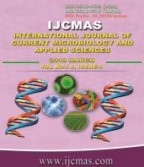


 National Academy of Agricultural Sciences (NAAS)
National Academy of Agricultural Sciences (NAAS)

|
PRINT ISSN : 2319-7692
Online ISSN : 2319-7706 Issues : 12 per year Publisher : Excellent Publishers Email : editorijcmas@gmail.com / submit@ijcmas.com Editor-in-chief: Dr.M.Prakash Index Copernicus ICV 2018: 95.39 NAAS RATING 2020: 5.38 |
Rice is the staple food of Telangana State requires about 50 lakh tons annually to feed the population. Rice is being cultivated both in kharif and rabi season as one of the most important crop in Telangana. During the year, 2017-18 rice crop was grown in an area of about 17.2 lakh hectares and produced 58.3 lakh tons of rice with the productivity of 3387 kg/ha. Comparing the productivity of rice over other states, Telangana was in first place by crossing the leading states like Punjab, Haryana, Tamilnadu and Andhra Pradesh. Manual transplanting involves lot of drudgery and requires 250-300 man hours/ha. Further, due to rapid industrialization and migration of labor to urban areas, manual transplanting was found costly leading to reduced profits to farmers. Self propelled paddy transplanters have been using in the state for some time by using mat type nursery raised in plastic trays or in the field itself. In this study six numbers of four row, four numbers of six row and two numbers of eight rows of seven manufacturing companies were evaluated in the sandy clay loam soil to see the feasibility of transplanters to be supplied to the progressive farmers in the state by the Govt. of Telangana. Nursery was raised in the field by spreading 60 micron polythene sheet over the wet soil and sprinkled the paddy grain on the soil. The average forward speed of transplanters was observed at 2.5 km/h. The number of seedlings/hill was observed as 3-8. The plant to plant spacing and row to row spacing range was observed as 12.0 to 17.5 cm and 23.8 to 30 cm respectively. The average field capacity, fuel consumption and field efficiency of riding type transplanters varied from 0.2 to 0.46 ha/h, 1.3 to 2.3 lit/h and 74.88 to 81.33 per cent respectively and the field capacity, field efficiency, fuel consumption of different walk behind type transplanters ranged from 0.33 to 0.38 ha/h, 75.12 to 81.27% and 1.4 to 1.7 l/h respectively.
 |
 |
 |
 |
 |